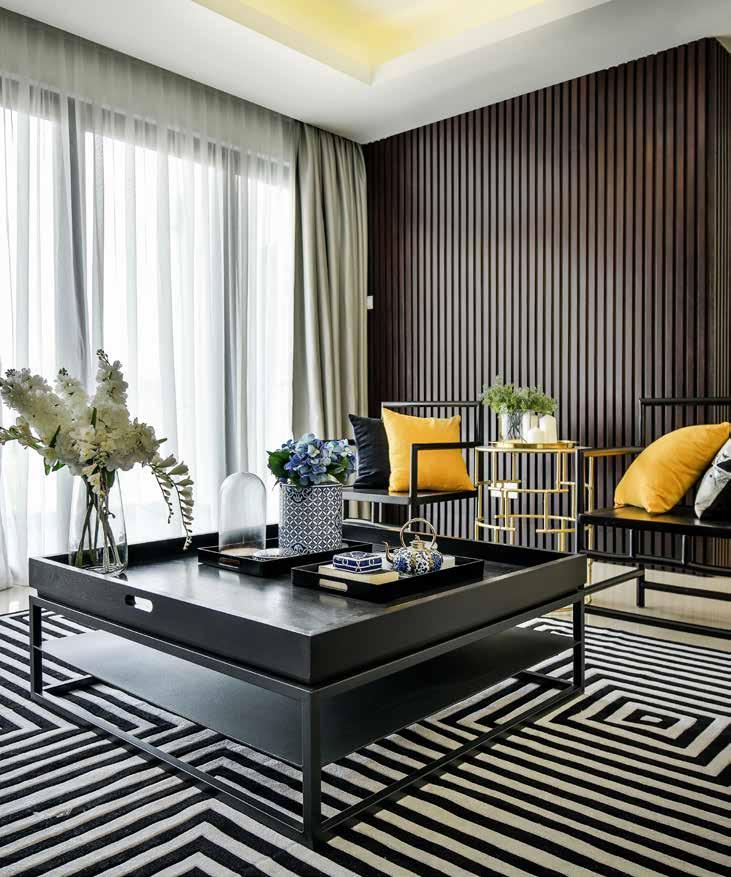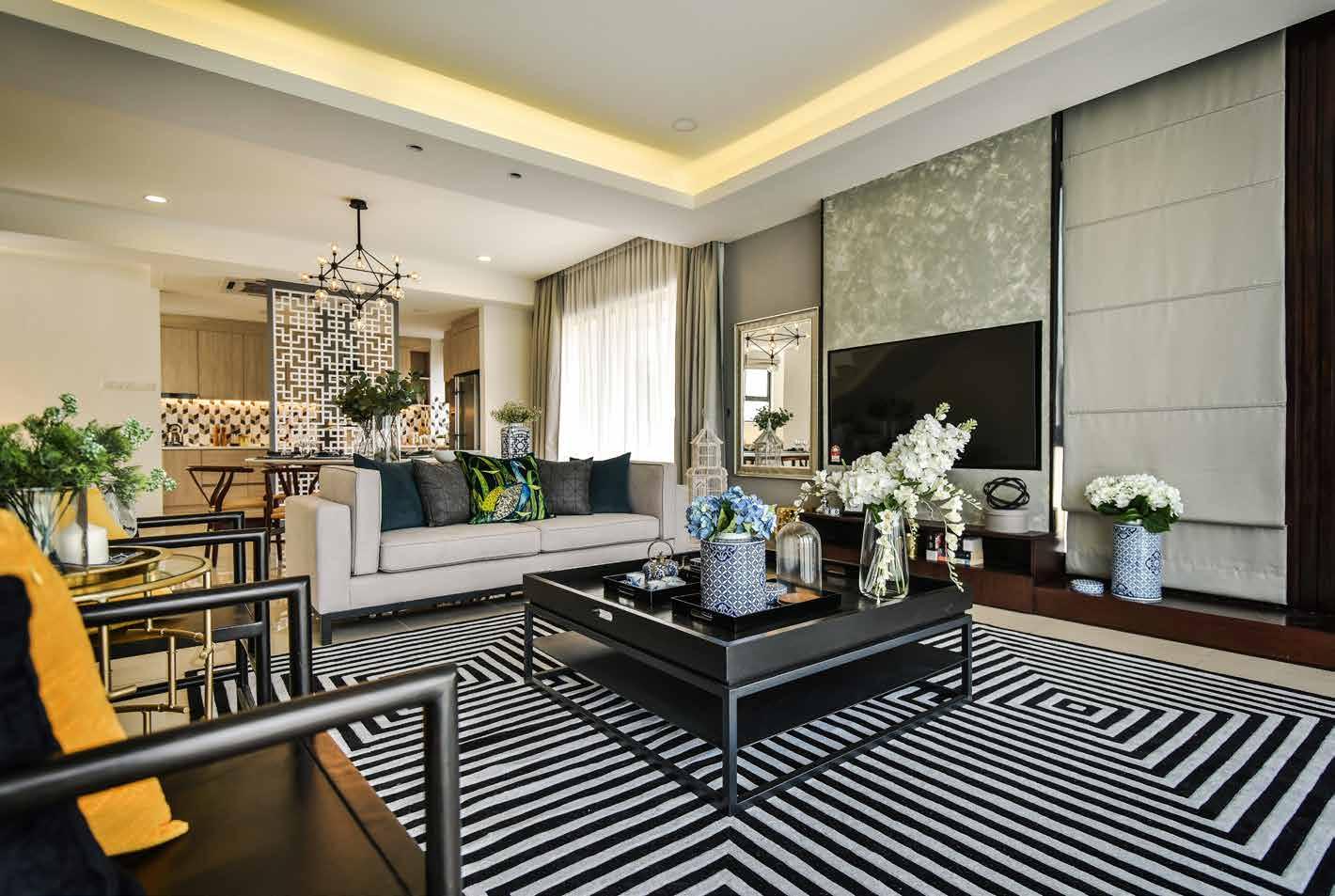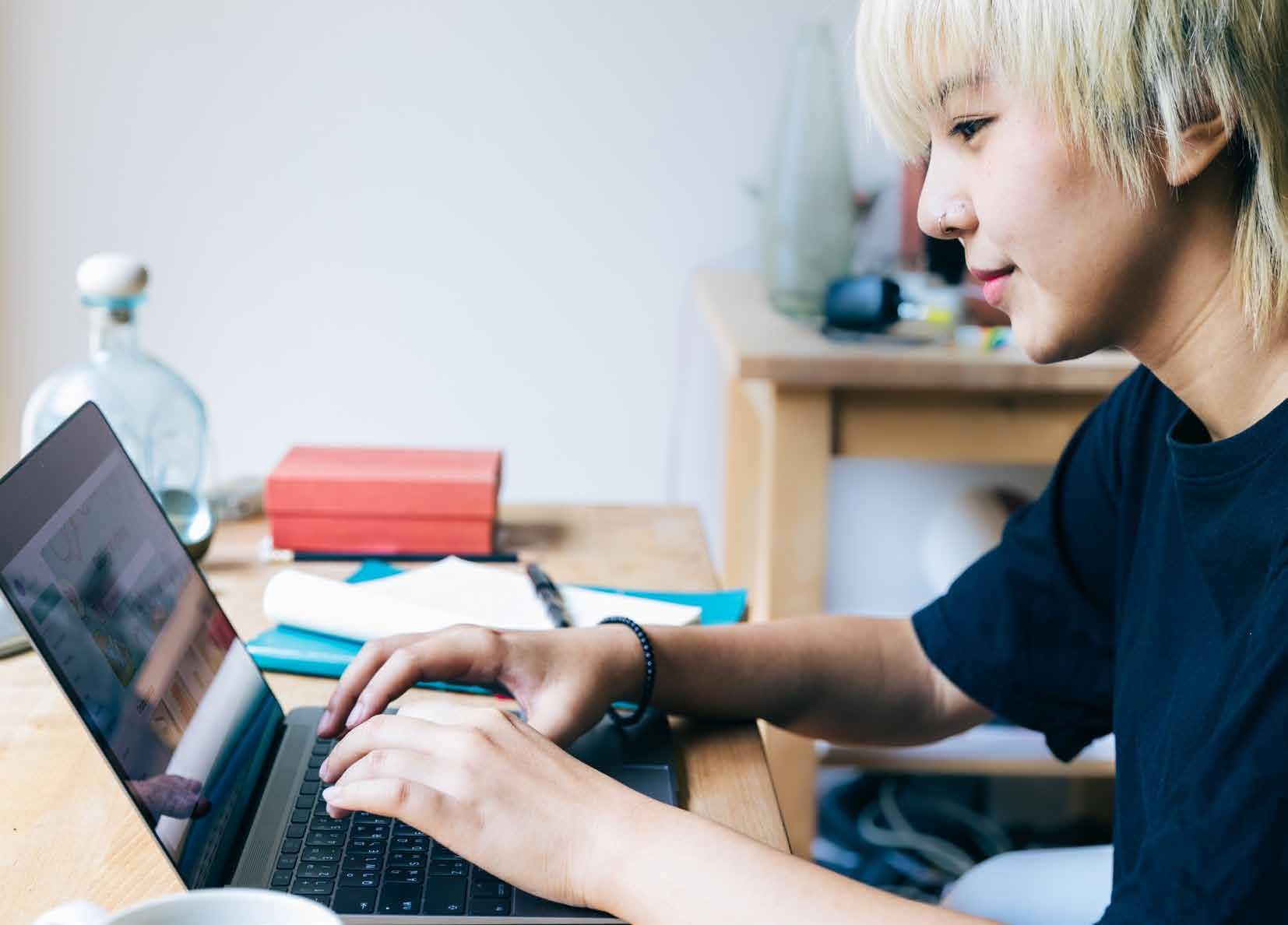
26 minute read
08 IMPACT ASSESSMENT OF THE MOVEMENT
THE IMPACT OF COVID-19 ON INTERIOR DESIGN STUDENTS & ACADEMICIANS
A special report by the MIID Education Committee
Advertisement
Almost no industry has been spared
from the effects of the COVID-19 crisis. With the social distancing and stay-at-home requirements, the education sector has had to switch to online-based learning in a very short period of time.
We interviewed a few students and lecturers to find out how they are coping during this extraordinary time, to get a sense of the way the crisis has impacted their learning experience, the challenges that they are facing, what they feel the government could do to assist the situation further, as well as what changes they forsee for Interior Design eduction in the next year and the future.
Note: The following interviews have been edited for clarity.
Sheik Irfaan Mustun MIID Membership No: S3093
As a student, how has COVID-19 impacted the way you learn?
COVID-19 at first, I thought was going to be a huge barrier to my learning process, as I am in my final semester and I was quite worried about my productivity and quality of work that I was going to be able to produce. However, to my surprise, now that I am one month ahead in my final year project presentation, I feel like I have had quite positive gains. I learned how to be more independent and develop my work gradually on my own rather than to overly depend on my lecturers; but maybe this won’t be true for first-year students. Being able to adapt to various situations is a great skill for a designer.
What’s the most challenging part about learning online? How do you overcome it?
Doing models and being creative can be challenging, but not hard to overcome as I learned during this time that creativity comes around restrictions. Restrictions, I realised, is a creativity booster. Breaking routine when staying at home is also very important to keep being focused and productive.
In your opinion, what could the government do to assist the situation further?
I think the government can focus on creating a safe environment for work and learning.
How do you foresee interior design education changing within the next year?
Certainly with new technologies interior design can cope with the challenges, but one thing that needs to be accentuated is the basics of design, understanding and mastery of it. New technologies and digitalization of design work may be counterproductive.
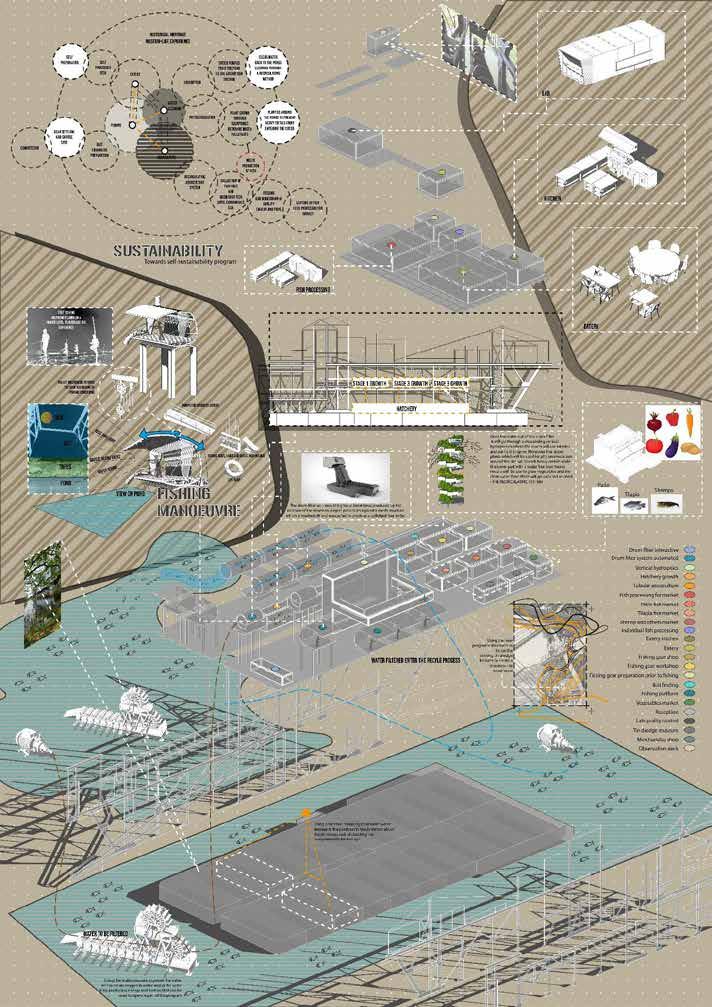
Programming boards for the final semester.
Drawing the site in 3D using only pictures as we cannot go for site visits.


First view of the space after development, slowly getting to the final form.

After sketching in a section view, I trace on CAD before building the 3D in SketchUp.
Kee Zhi Xian
MIID Membership No: S3637
As a student, how has COVID-19 impacted the way you learn?
The COVID-19 crisis has completely changed the way we learn and do things. Normally, I’m a very hands-on person, I really need to make something physically to generate ideas, and meeting in person is much clearer and easier to understand. But online learning has stopped me from doing that.
What’s the most challenging part about learning online? How do you overcome it?
The most challenging part is to do everything virtually. To “make” models virtually is much harder as we won’t able to touch and feel the relationship and connection between things and might not be able to generate good ideas. To overcome this, I just need a lot more time to adapt to this situation. In conclusion, this can’t be overcome in a short time. I still prefer physical classes and meetings.
In your opinion, what could the government do to assist the situation further?
I think the government needs to find ways to continuing having physical classes, and if virtual meetings still need to go on, maybe the government can try to come out with much better platforms for each and every field. Because every field has different needs and requirements, and design needs a lot more “physical” and user-friendly platforms.
How do you foresee interior design education changing within the next year?
I think if design education needs to be in the virtual, online world, I think the “results” of it will not be as good as the results now. This is because design can’t be taught online as easily as other courses.
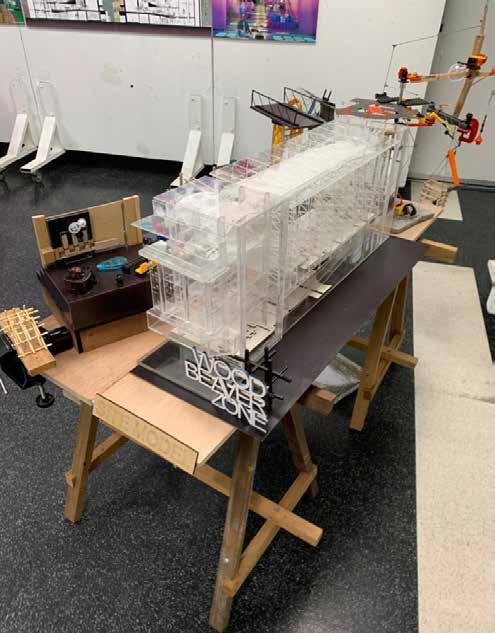
“Making” models virtually is challenging.
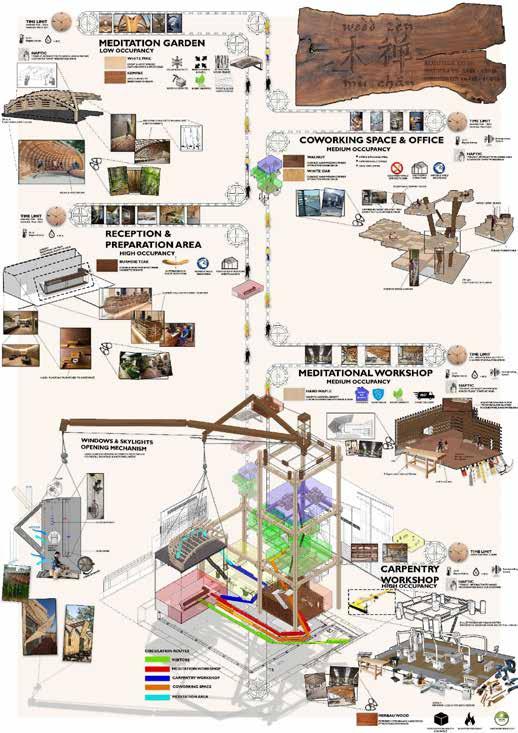
Programming boards for final semester.
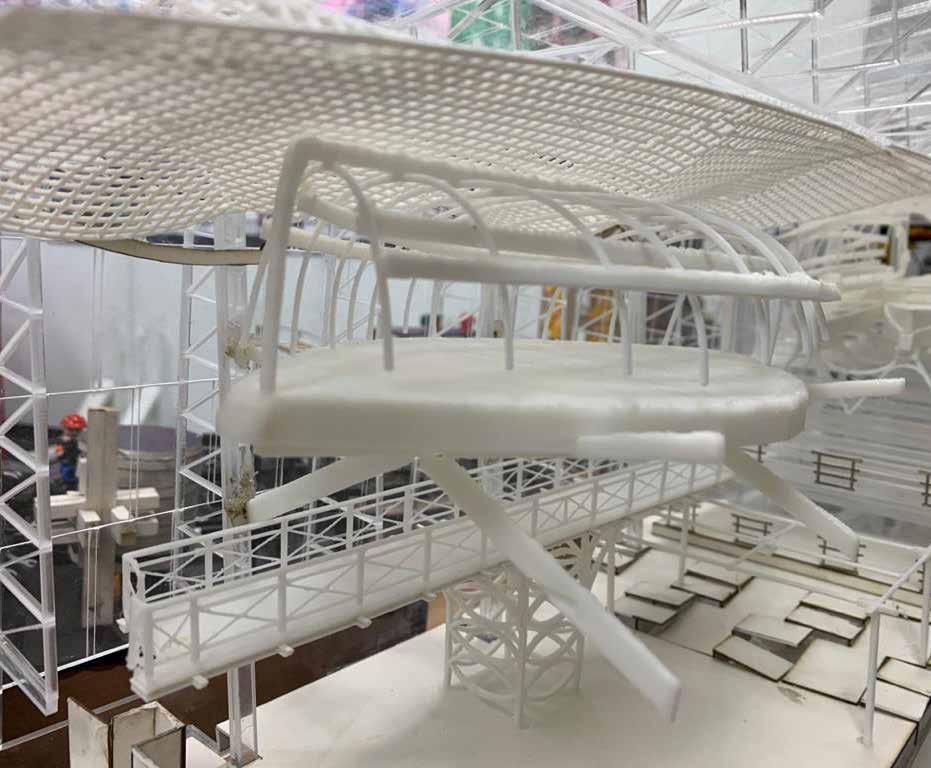
Not being able to touch and feel the relationship and connection between things makes it harder to generate good ideas.
IDr Mohd Redzwan Hisham bin Bidin
Senior Lecturer Taylors University Lakeside Campus MIID Membership No: M135
Simplifying notes for online workshops.
As a lecturer, how has COVID-19 impacted the way you teach?
As a part of the teaching faculty, we have experienced new ways of teaching; something that we have never thought possible. Especially in tutoring studio related subjects, we have encountered digital sketch-assist using drawing tablets (mirroring to the PC), live online demonstrations and video recording. It was not easy in the beginning as the university management was doing regular check-ups for quality assurance, and providing us with various online trainings and discussions besides our regular weekly classes.
What’s the most challenging part about teaching online? How do you overcome it?
The most challenging part of this issue was planning and changing the plan to suit the situation. We must be confident and ‘follow the flow’ as there are many platforms for teaching and learning online such as YouTube, Vimeo, Google Classroom,
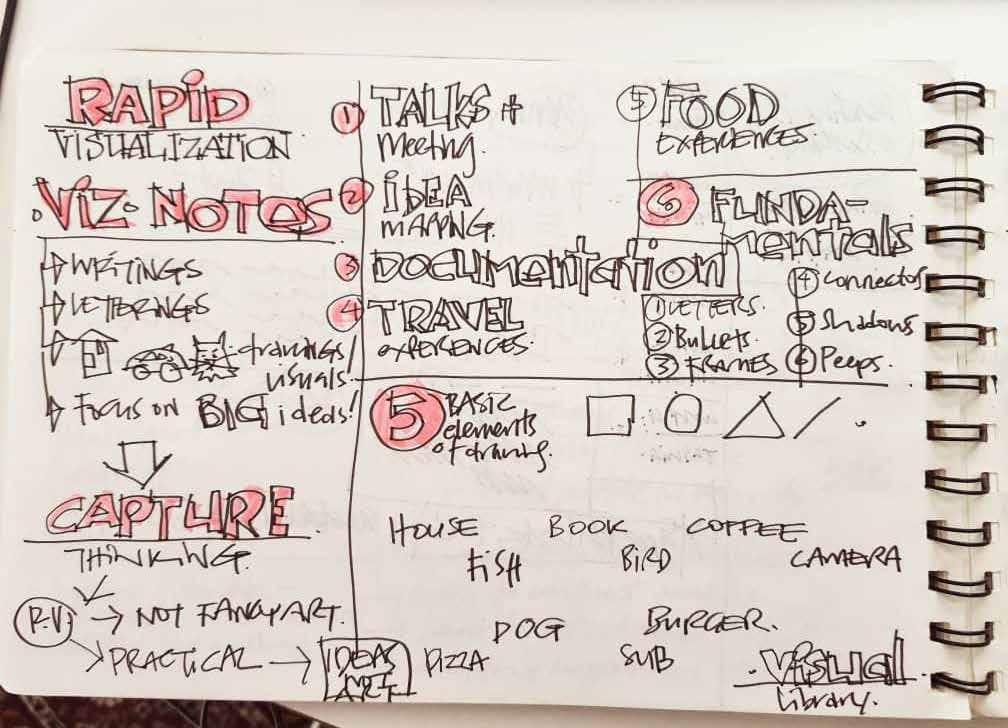
Zoom etc. Some of us managed to go online to buy tripods, LED lightings and microphones to make our video recording and demonstrations better and clearer.
In your opinion, what could the government do to assist the situation further?
The government should build more infrastructure for online facilities and encourage more flexibility and research in handling online education, with a well-balanced consideration to include hands-on and face-to-face education to a certain extent.
How do you foresee interior design education changing within the next year?
I see there will be changes within the next year as more universities and colleges are doing online critique sessions and virtual exhibitions with some involvement from international critics and designers. This scenario will see our design education move into a different exposure and new heights.
Online classes with laptop, tablet/iPad and sketchbook.
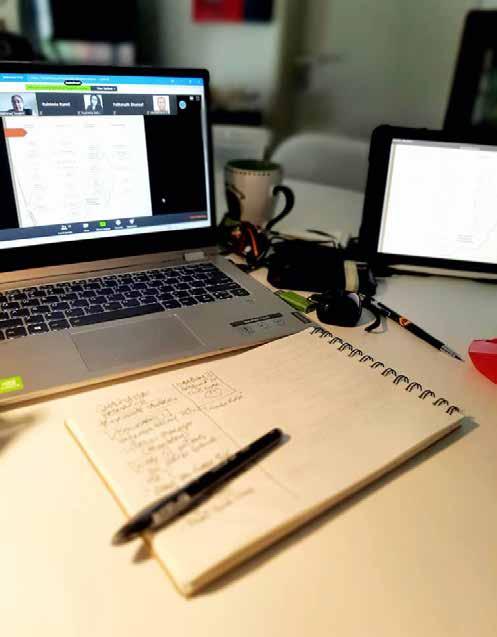
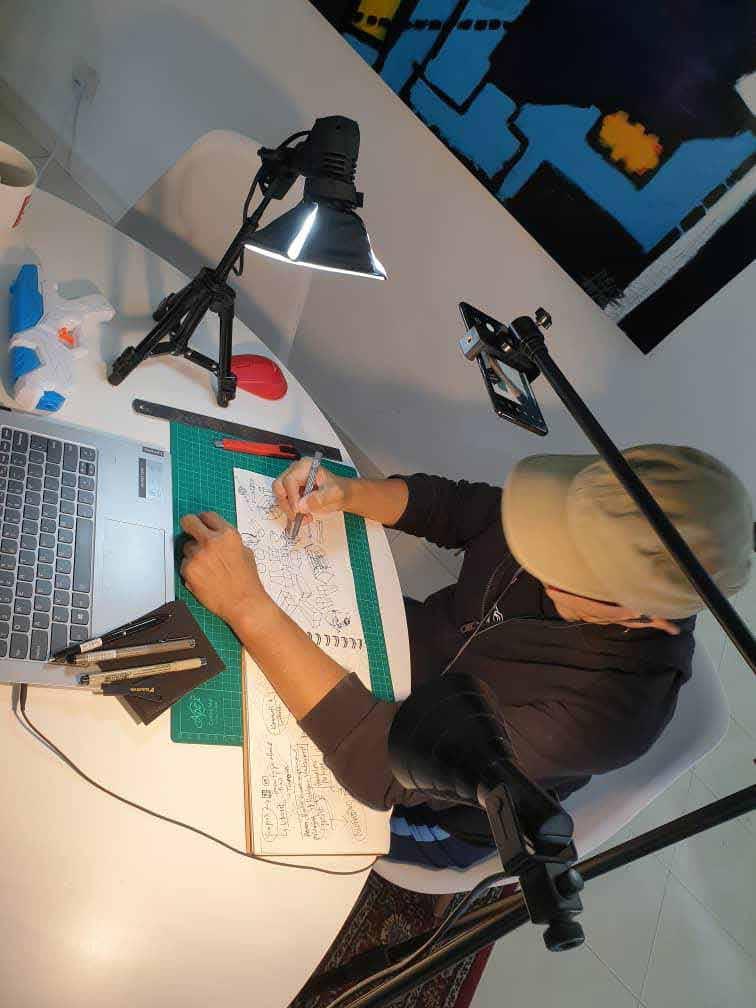
Basic video recording setup: tripods for phone, LED lighting and microphone.
Dr Muhammad Firzan bin Abdul Aziz
Senior Lecturer of the Interior Architecture Programme, School of Housing, Building and Planning Universiti Sains Malaysia MIID Membership No: E68
As a lecturer, how has COVID-19 impacted the way you teach?
It is fair to say that COVID-19 has rendered the global educational scene into disarray. The impact of this unprecedented pandemic to the realm of teaching and learning should not be understated. Undoubtedly, the Movement Control Order (MCO) imposed by the Malaysian government is a helpful and an effective preventive measure to combat the spread of the virus. Its implementation however, has brought about some challenges and setbacks for educators and students alike, to carry on the normal face-to-face classes or lectures. This predicament has triggered a new norm – a shift to remote teaching and distance learning via online platforms.

The small corner of my mini home studio where I normally conduct my online teaching and learning activities following the work from home (WFH) requirement during the MCO period.
As a public university lecturer, I personally believe that this adversity is also a blessing in disguise for me and my counterparts. One of the perks of having work-from-home (WFH) made compulsory during the MCO period is that we do not have to commute to the office on daily basis. This is considered a privilege, where educators could utilise our extra time to familiarise ourselves with the whole new world of digital teaching and learning platforms that are pervasively available online. As a matter of fact, I consider myself uber lucky to have enrolled in a compulsory teaching and learning course prior to the MCO, organised by the Centre for Development of Academic Excellence (CDAE) of Universiti Sains Malaysia (USM), where emerging lecturers are exclusively coached by the National Academic Award winners in the likes of Prof. Karim Alias, Prof. Zainal Ahmad and Assoc. Prof. Azidah Abu Ziden. It has not only changed my view, but also enhanced the understanding and developed my proficiency in online teaching and learning by leaps and bounds. Upon the completion of the course, I managed to get my digital teaching portfolio (bit.ly/z10zelearn) ready, and was itching to delve into making full use of USM’s very own integrated eLearning platform.
In this regard, teaching in the new normal is intriguing and experimental to me. Up to this day, I am still exploring the different platforms for synchronous teaching such as Webex, Zoom, and
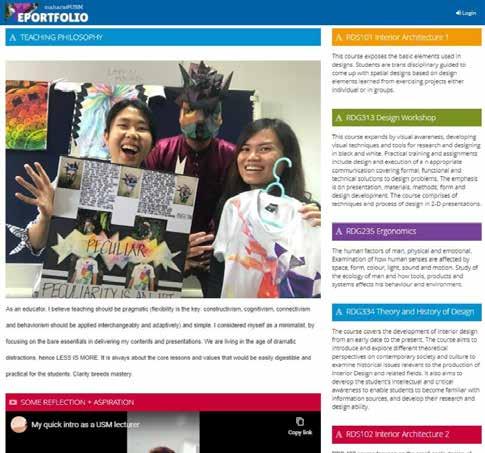
A sneak peek into my digital teaching portfolio developed through mahara@USM
Microsoft Teams. For asynchronous teaching, I am fond of several online interactive tools such as Mentimeter, Loom, Flipgrid, and Padlet. These tools are excellent in engaging students and holding their attention longer while going virtual. Meanwhile, WhatsApp and Telegram are among the ideal alternatives to cater to issues of limited data quotas, poor internet connectivity, and unavailability of high-end gadgets or computer equipment that potentially trouble underprivileged students.
What’s the most challenging part about teaching online? How do you overcome it?
When the pandemic calls for global lockdown, the conventional face-to-face teaching and learning process turned impractical. It consequently forces the educational world to shift to a new paradigm of emergency remote teaching and learning. This scenario is apparently not suited for everyone as we can see some are pleased with the implementation whereas others find it vexing. The skillsets (technological and technical competencies) could potentially add up to the obstacles of emergency remote teaching and learning. However, the main obstacle preventing educators from adapting to remote teaching and learning is their limiting mindset. I personally feel that one needs to adopt a growth mindset while navigating these days of uncertainty. It is sensible that online means demand strategic planning and effective delivery to fully match the effectiveness of offline means.
From my very own limited experience, I can sense that there is a lack of established connection between my students and I during our online lectures. There are times where I got quite frustrated whenever I realised that the conducted sessions did not really
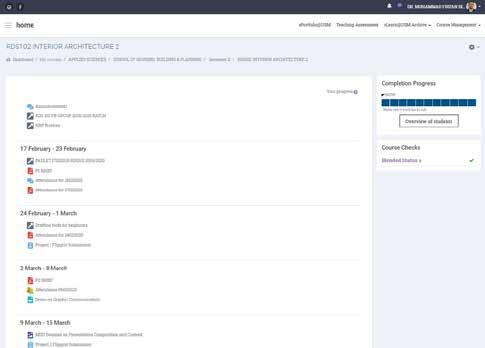
A snapshot of the interface of USM e-learning platform where students are equipped with learning materials during the MCO period.
happen in a two-way communication. I believe most lecturers would agree that at some point we tend to be disappointed with the timidity of students when they refuse to switch on their cameras or hesitate to give prompt responses when required during our ongoing online sessions.
Online lectures and classes require ongoing interactions between the educator and students to be deemed fruitful. Lecturers anticipate a certain level of commitment and active engagement from most students. Nevertheless, it is wise to be apprehensive that online mode is not for everyone and the thing that matters the most is the students’ comprehension of the lessons taught. My very own methods of ensuring that students get the gist out of every lesson taught online is by:
i. stripping away all the complexities of each lecture topic by making them compact, minimal, and palatable to students to lock their focus within the few limited hours (the gen-Z is living in a world of dramatic distractions which results in very short attention spans); ii. making some contextual associations of the lecture topics to relevant contemporary issues or trends of the students’ interests (understanding the pop-culture, jokes, and memes as well as common hashtags popular among the gen-Z really helps); iii. requesting students to have advance preparation prior to commencing studio, class, or lecture sessions (lecturers should be ingenious by facilitating easy access to relevant and highquality online materials, and serve more as a content curator rather than a content creator); and iv. prompting formative assessments after each of the taught sessions (I love to ask my students to reflect on the key learning points upon the completion of my online sessions, in which the submitted responses will be accounted as their attendance record).
On a serious note, the only thing that goes beyond the importance of students’ active participation and engagement is their online presence. In this regard, I have always found that Facebook groups as well as the WhatsApp application offer interesting features in disseminating immediate or important information such as instructions, notifications, or requests. These platforms enable lecturers to keep track of students’ involvement by checking the ‘seen’ status of their post. Thus, it is very helpful for lecturers in the current scenario as we can know whether our postings have been read by our students or otherwise. In this way, monitoring the case of students being left out or missing in action due to whatever reasons is made possible.
In your opinion, what could the government do to assist the situation further?
From my point of view, accessibility is the ultimate key when it comes to teaching and learning online. The government should put concerted efforts in ensuring students of different levels, from every locality are not overlooked in their quest of online learning. The government’s effort of enabling high-speed internet connections in rural areas, increasing the complementary 1 GB data limit and provision of ideal gadgets or computer devices to students of lowincome families have been very helpful. Let’s not forget that our students are the future leaders, hence allocating an amount of budget that profoundly eases their quest for knowledge is a such a worthwhile investment that any government in the world should contribute for the betterment of its country.
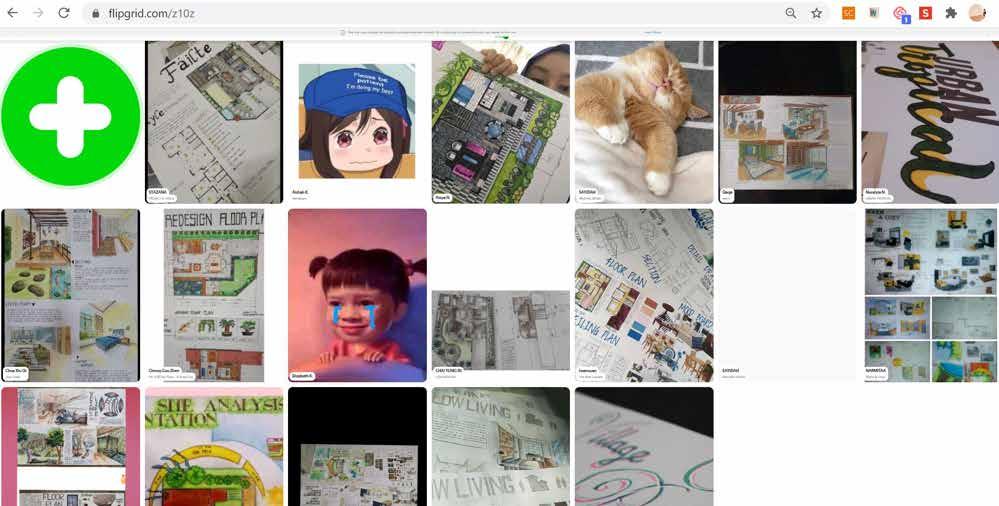
Students presented their design studio projects (video recording) via Flipgrid as an alternative to oral presentations which require their physical presence.
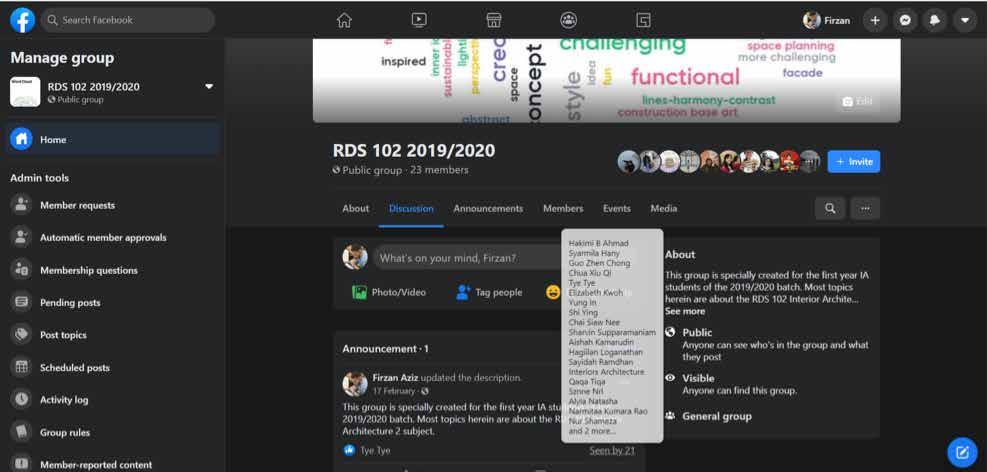
The ‘seen’ status feature in FB groups makes online monitoring and following up with my students easier.
How do you foresee interior design education changing within the next year?
Learning interior design involves all the three cognitive, affective, and psychomotor domains. Plus, fluency in social interpersonal skills would be advantageous. It would be a challenge to capture these aspects through a full online mode. Hence, extending the period of non-face-to-face teaching and learning post-MCO especially for design studio subjects is against the requirements of the Malaysian Council of Architectural Accreditation and Education (MAPS).
In the next year, I foresee that some of the non-design courses within interior design education will resume via online, while design courses, especially design studio, will have to be carried out face-toface with the physical presence of the studio masters. Therefore, the first-year and final-year students will be our priority, as the former needs guidance with the essentials of interior design, while the latter needs to be polished to be ready and have the capacity to venture into the real practice in the built environment field. Hence, going on online mode for the design studio subject is almost impossible as interior design students are required to undergo site visits and perform site analysis, solving problems both individually and collaboratively with their peers, assisting and competing healthily with their studio mates, attending critique sessions with lecturers and other experts, and so on.
In this regard, I predict that in the year 2021 there will be a significant reduction in physical classes and lectures within public universities especially during the first semester, as it is one of the preventive measures concerning everyone’s health and safety.
Nurul Izzati binti Osman Zakba
MIID Membership No: S3302
As a student, how has COVID-19 impacted the way you learn?
COVID-19 has been sweeping the nation off-track in academic and economic aspects. The outbreak is affecting academic progress of the students especially in terms of motivation and commitment.
The semester’s studies have been lagging. In the first month of the MCO in March, there was nothing progressive for student development in terms of their studies. Turning the first month into a holiday month, it provided time for the students to catch up on their hobbies instead. Some of the students took this chance to improve and train their skills. These could be seen through the stream of artworks posted on social media, triggering inspiration to the youth souls all around the world. As the MCO duration increased, the learning sessions were then converted to online classes; to not let 2020 pass by with nothing. Online classes were held on various platforms – Zoom, Webex, Microsoft Teams, etc. The lecturers also expanded their efforts in providing different options in teaching to make it more interesting and fun for the students, such as inviting figures of the industry to give talks, based on the real situation happening in the industry. However, the long duration of the MCO had unexpectedly made students less motivated than before, as if there was no commitment given to the work they produced. In addition, the lockdown had impacted the students’ mental health, especially those who are sociable and active during their study time. Social interaction is an important factor in our lives, and without it, we students tend to get more depressed and stressed. Chasing the due date, raising ourselves to the expectations of the lecturers with the criteria and conditions they have set has been the toughest situation to handle. It could go downhill from here; but we are trying to balance it out, learning to cope and adapting ourselves to this new environment.

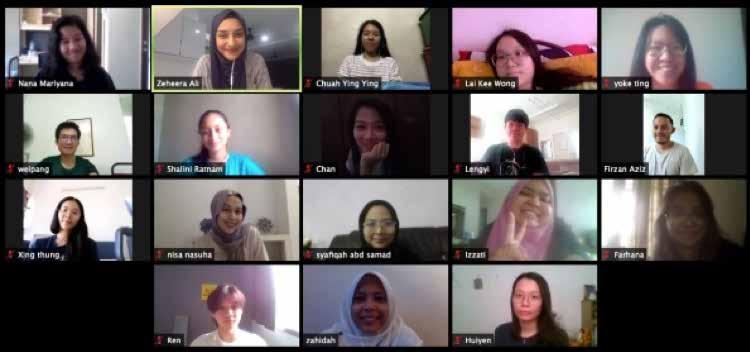
During an online lecture session with an invited guest speaker.
What’s the most challenging part about learning online? How do you overcome it?
The most challenging part about learning online is the internet coverage and speed. Lagging internet speeds disrupt the lecture sessions the learning process itself. The students may miss certain important information given during the classes, which subsequently makes it harder for them to keep up with the lesson as time passes. For students who stay in the city area, this may not be a big issue. However, for those who live in the outskirts, such as myself, this affected the lessons in negative ways. Students have no other way to overcome them other than for asking the lecturer to record the online sessions done for further review, or to inquire the information given from classmates instead. This problem sets a huge number of students back from experiencing the full atmosphere of what an “online class” could be, and eventually affecting the students’ performance in classes due to the technical issues faced.
Another challenging part is balancing the time for studies, metime and family. Staying at home makes it hard to do so. Before, during studies students were mostly situated in the campus, thus they could focus on work alone. However, being at home somehow brings about this guilty unfilial feeling as they always spend time on assignments rather than with the family or helping with house chores. Hence, to separate time equally among studies and family beforehand is needed to ensure the other sides don’t take our actions to heart.
The last one is to stay motivated. The fighting spirit in studies just keeps on dimming. No physical interaction with lecturers and classmates makes it harder to stay motivated. No exchanging of views and thoughts except for critic sessions done through texts and words. Due to the lack of clear communication between the students and the lecturers, students end up inquiring one another in regards to the progress instead, to ensure that they are not left behind. This act may not be successful at times, as sometimes we are left with nothing but confusion and anxiety as to whether what we are doing is right or wrong.
In your opinion, what could the government do to assist the situation further?
Providing daily free internet is helpful enough for the student. However, it might be inadequate for some who need to keep on searching for further information to do their assignments. Online counselling sessions should be provided for students that need it, to ensure the students are alright and have a place for them to turn to for help. The government should encourage the lecturers to record the online learning sessions or provide other options that the students could benefit from educationally, in order to help those who have poor internet coverage across the country.
How do you foresee interior design education changing within the next year?
Somehow, the interior design education/sphere will change that instead of by book learning, students might expose themselves more to the real-life industry and practical situations. Students have more chances to experience or to know more about the industry through these methods instead. Interior design talks done on online platforms makes it widely accessible – which gives equal opportunities for students studying the course worldwide – disregarding other factors (such as financial). Students will have more access to online learning experiences and networking through endless possibilities provided for us by new technologies in this new age.
Tuqa Mamdouh Aboueleiz Ibrahim Mohamed
MIID Membership No: S3313
As a student, how has COVID-19 impacted the way you learn?
COVID-19 did not change the way to learn or teach, only that it challenged our lifestyles and it shed light on all the aspects of life that we never looked upon or gave attention to before. As a student that has been always learning through classes, workshops and studio; changing to online learning in the span of few days was difficult as no one was truly prepared or ready for the drastic changes that would come in teaching (lecturers) and receiving the information (students).
Earlier on, the impact of COVID-19 on the academic aspect was different from one university to another. Some chose to postpone the semester until the situation dies down and steps in handling it were clearer. Whereas some other universities chooses to continue their semester as usual and adjust to the new changes as time went on. Both decisions had their own benefits and disadvantages, however, the constant confusion and worry in continuing studying or extending the study time due to COVID-19 was a common thing experienced by all students at some point. It was a blessing to know that USM chose to continue the semester as normal through online learning. The impact of the pandemic was more obvious after online classes started; as the lecturers were not ready for such a change and due to that, most of the lecturers did not do well in teaching while some tried to find the best solutions/ways to teach. It was pressuring and demanding to both the students and the lecturers. Students had to manage their time and still be motivated to do work and produce good work with all the things that are happening around them – from worrying about their health and their families, to being stranded on campus and being far from home.
What’s the most challenging part about learning online? How do you overcome it?
The most challenging part about online learning is maintaining a healthy mental state with all the pressure, worries, and changes that is going around. As we need to social distance and for the most part stay by our own self, it can get depressing and if not handled well, it could definitely escalate further to excessive depression and anxiety. Not being in a healthy state of mind can affect every aspect of life; especially students as we need to keep learning and constantly producing creative work! However, social media was one of the options available to let out some of our worries and find comfort in friends and family members when we can’t be with them physically. Unfortunately, that may not be the solution for everyone, as some experience social anxiety (whether it be in real-life or online) which results in immense pressure, making it worse for them. Overcoming such an issue is a complex work that not only needs to be done by the person struggling, but the surrounding environment and the people around him/her as well. The lecturers and students need to have such awareness either to ask and understand, or comfort and seek help whenever such issues arise.
In your opinion, what could the government do to assist the situation further?
Providing free psychological sessions by phone or video calls to

Maintaining a healthy mental state is important in these challenging times.
everyone that is in need, and weekly check-in calls especially for the people staying on their own or far away from their family to make sure of their well-being and mental state. To also provide free, temporary healthcare for foreigners and citizens because of the economic state that we are currently in. Work is no longer beneficial enough, and foreigners that cannot go back and cannot work can still be checked and provided with healthcare.
How do you foresee interior design education changing within the next year?
Due to such a world-changing pandemic, the industry should focus more on the ability of young designers to adapt to change and work in different conditions, while encouraging good communication skills that can be implemented in real-life or virtual situations. Moreover, the industry needs to adapt fast to new technology and embed in its work such as VR (Virtual Reality) graphics so it can be used as an alternative to design boards and meetings. The online world is becoming an essential place and is asserting itself as the main medium for us humans to communicate and promote ourselves as citizens of the world. Hence, in the following years, the industry should focus on what could be done and improved through the internet – now more than ever.
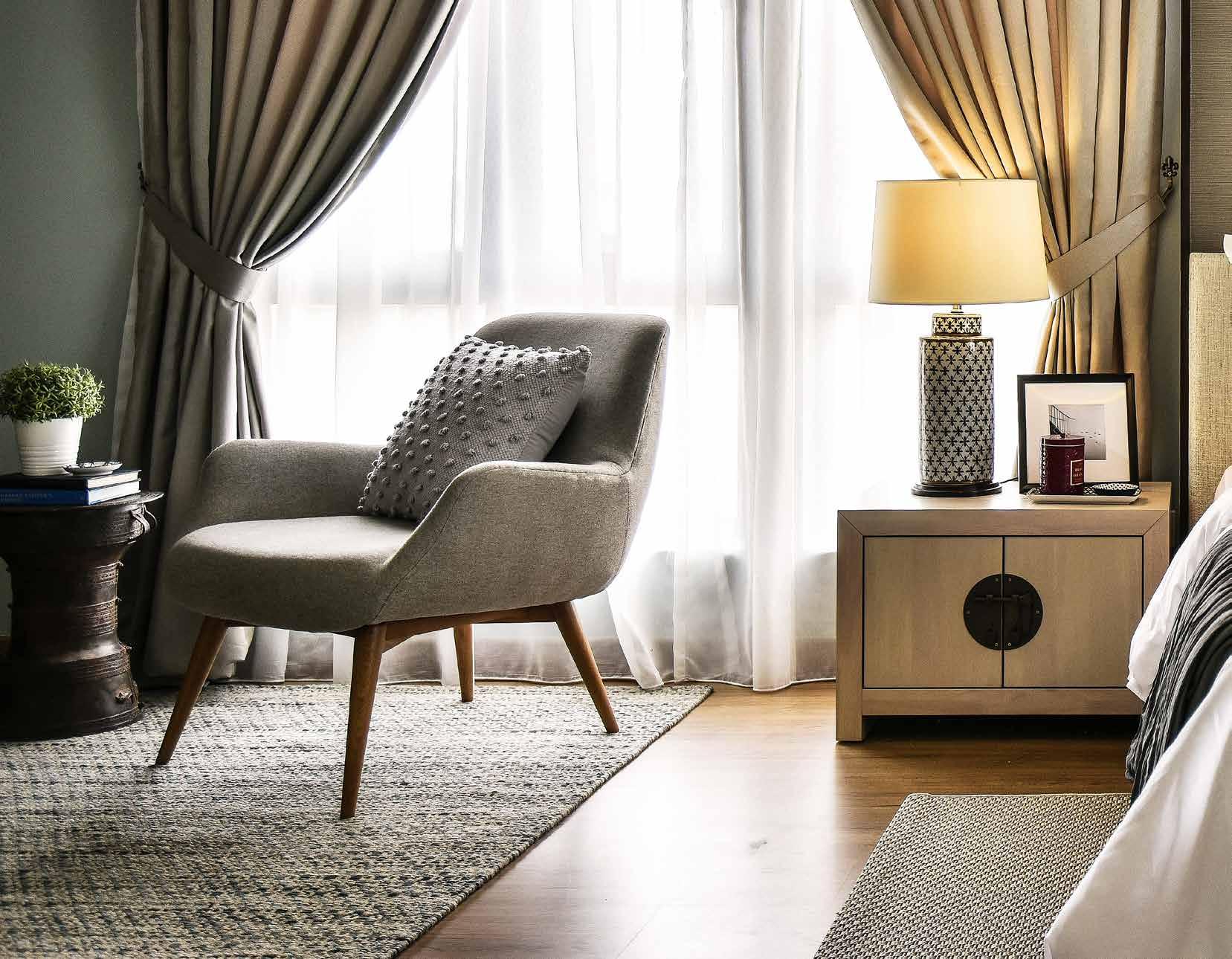
KEY INFO:
Interior Designer
Innovative Space
Dimension Sdn Bhd
Client
Titijaya Land Berhad
Date of completion October 2018
MIID REKA AWARDS 2019 - SILVER AWARD WINNER - SHOW UNITS TITIJAYA - PARK RESIDENCY SHOW HOUSE UNIT
The Park Residency
show house unit is a 3-storey link-villa (Type C) in a new and upcoming neighbourhood located in Alam Damai, Cheras.
Principal interior designer, IDr. Ronnie Choong Swee Beng talks about the design.
What was your design inspiration for this project?
The concept of this show unit explores one of the most powerful tools when it comes to creating a connection between an audience and an interior space – nostalgia. A well-designed living space that evokes a sense of nostalgia within its residents allows them to feel more at home and a sense of belonging, as they reminisce the familiarity of the past, of their childhood and of their ancestors. Such an ambience is what makes a residential show unit outstanding and different than the rest, as it creates a story that potential buyers can mould into their imagined life as they tour around the interior space of the show unit.
Could you elaborate on your ideation process for this project?
The concept is achieved through the juxtaposition of the traditional oriental elements and modern touches, which can be seen all the way from the design of the carpentry work, feature walls, loose furniture to styling items.
Warm, earthy tones are used as the base for the design of this entire show unit to give it a rich yet contemporary look, while pop of colours and whimsical touches that are synonymous with the oriental style are thrown into the mix as an unexpected twist.
Bespoke loose furniture designed to embody the marriage of the oriental and modern style are used in this show unit; staying

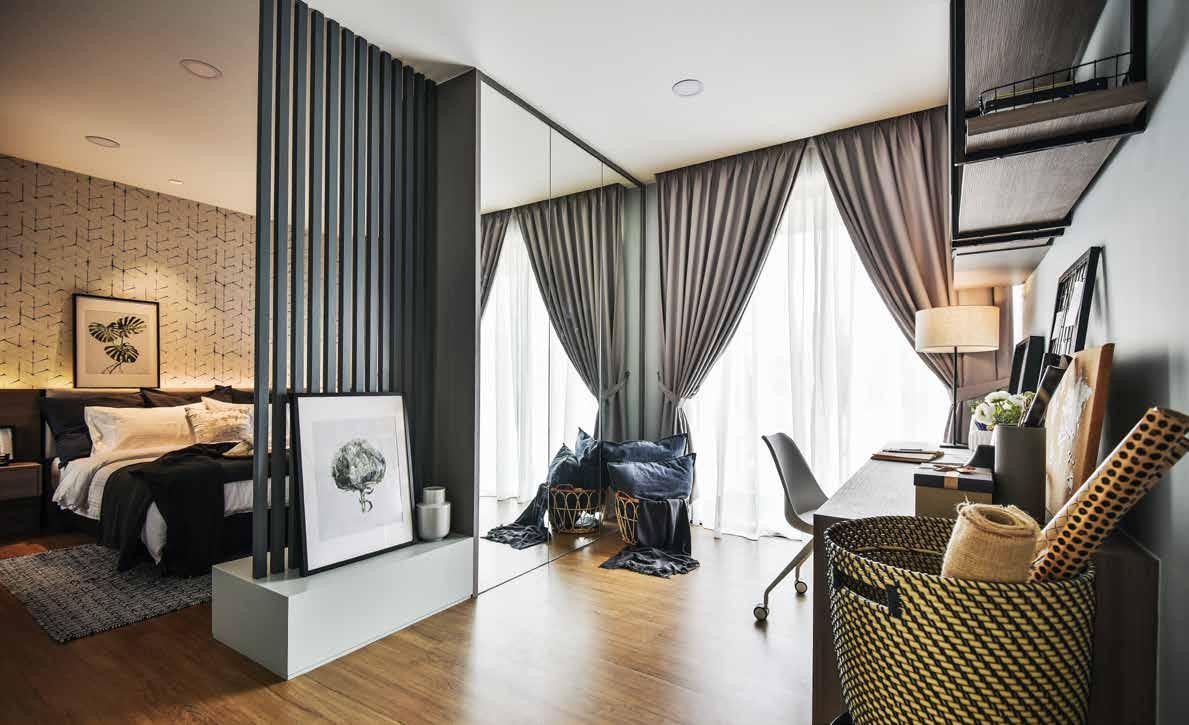
Above: The master bedroom was designed in a style that is true to the Modern Oriental concept, with customdesigned bed panel, TV cabinet, and walk-in wardrobe. The earthinspired colour scheme provides a calm and serene ambiance for the entire space.
Left: The second bedroom is targeted towards a young, millennial couple, designed in a more modern direction, but influences of the Modern Oriental can still be traced in this particular room, like the use of the timber strip wall screen that separates the two sections of the room.

true to the story and concept behind it.
The styling for this residential show unit was thoroughly chosen to represent the family who would be living there, where oriental-inspired pieces and modern items are combined to create a warm and inviting living space befitting of the lifestyle of the potential buyers.
Thoughtful space planning tailored for a family of two generations has resulted in a highly functional residential unit, by reconfiguring the original layout of the unit; together with detailed thoughts given to the orientation and placement of beds and wardrobe, and other furniture.
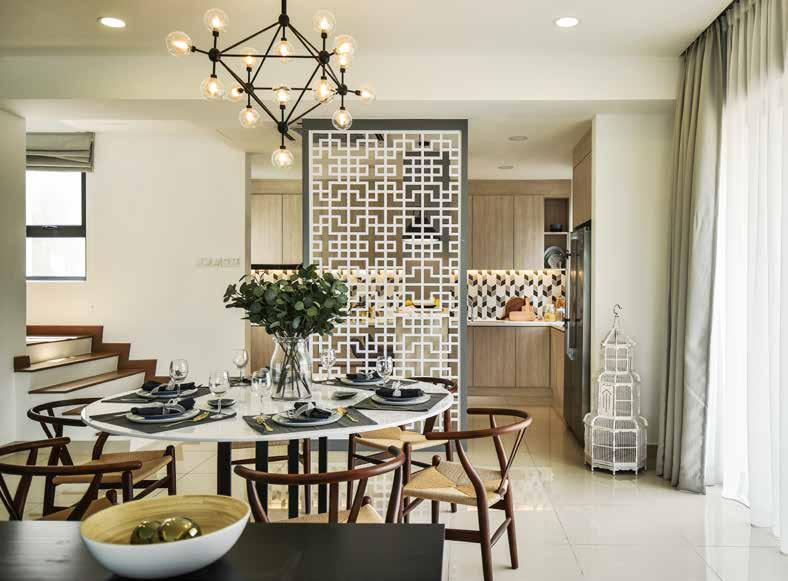

Top-of-Page: Located at the centre of the first floor, the dining room connects the living room and the kitchen, thus the furniture chosen for this area becomes a transition from the heavy toned living room to the bright toned kitchen.
Above: This room was designed in a refreshing modern style, complimented with a neutral colour palette.
Left: This oriental-motif partition screen was given a modern touch through the fresh combination of white and grey; and divides the living room and kitchen and creates a sense of privacy for the kitchen area. The bespoke dining table applies a modern take to the traditional round dining tables that are often used in oriental dining spaces – with the minimally designed leg in black powder-coated finish, topped with a sleek, white marble top.
Below: The chosen light toned timber laminate for the kitchen cabinet gives off a warm, cosy ambiance, while the use of the backsplash with such a bold pattern adds character to the whole space.
Right: Rich toned timber strips, mixed with special paint and sleek clean lines for the TV cabinet embody the concept Modern Oriental, making it the focal point of the living room. The bold black-andwhite loose rug was chosen in a pattern inspired by oriental patterns and symbols, while adding an interesting contrast to the space.
Bottom: Whimsical touches inspired by the folk stories and symbolism synonymous with the oriental style add the charm and character to this living room – like the throw cushion with a peacock motif, the pagoda-inspired bird cage, and the blue-and-white porcelain jars.

